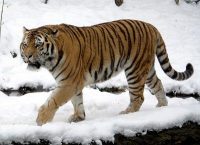We have researched some of the most interesting Siberian tiger facts. The Siberian tiger (Panthera tigris altaica) lives in the mountainous regions of the Russian Far East. There are less than 500 tigers remaining in the wild. Siberian tigers are also known as amur tiger, Korean tiger, Ussurian tiger, and Manchurian tiger. They are one of the biggest carnivorous land mammals—second only to polar bears. Let us now enjoy all these Siberian tiger facts and information.
Siberian Tiger Facts for Kids
ger has a rusty-reddish coat with black parallel lines. They reach a body length of 150 cm (60 in) with a 107–110 cm long tail. Siberian males can get to the size of 195 cm (77 in) and females 167 to 182 cm (66 to 72 in).
What do Siberian Tigers Eat? They are the biggest of the cats which is why they eat large animals including Siberian roe deer, sika deer, Manchurian wapiti, and wild boar. Siberian tigers are carnivores and they also prey on hares, salmon, and pikas.
Where do Siberian Tigers Live? Siberian cats make homes in a variety of habitats such as boreal mixed forests, Korean pine broadleaf forests, coniferous forests, and deciduous complex.
 Siberian male tigers weigh up to 180–306 kg whereas females measure 100–167 kg in weight.
Siberian male tigers weigh up to 180–306 kg whereas females measure 100–167 kg in weight.
As is typical of big cats Siberian tigers hunt animals by quietly walking towards the prey and begin the final charge when it reaches within 200 feet distance of the victim.
Siberian Tiger Lifespan: Siberian cats can live up to 10 – 15 years in the wild habitat. The average lifespan is probably greater in captivity.
Unlike any other living cat, Siberian cat can travel as much as 1,000 km. Sometimes they cross boundaries between the countries.
The female gives birth to 2 to 5 cubs and they are completely blind and helpless at birth.
Siberian tigers are highly endangered species. There are around 480 cats living in the Siberian forests.





